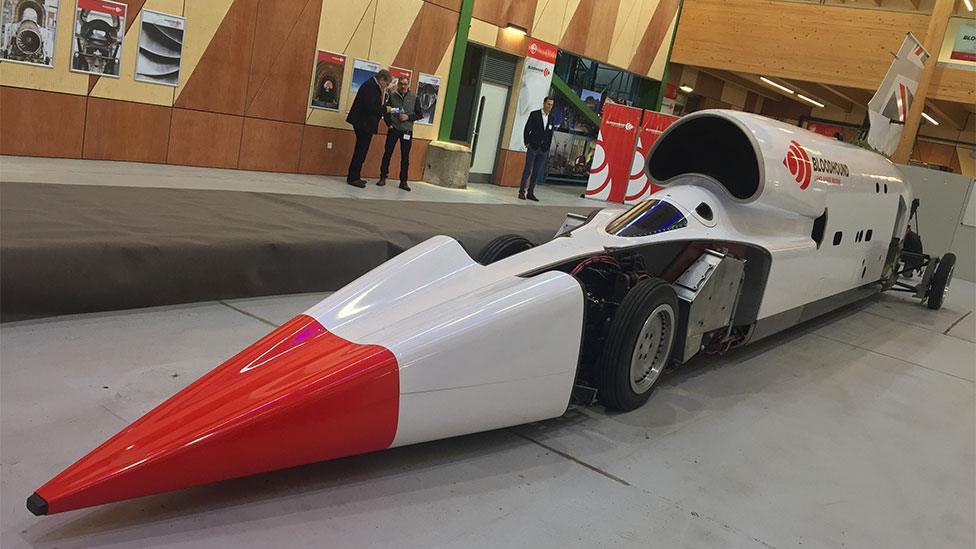Bloodhound diary: South African trials get under way
- Published

A British team is developing a car that will be capable of reaching 1,000mph (1,610km/h). Powered by a rocket bolted to a Eurofighter-Typhoon jet engine, the vehicle aims to show its potential by going progressively faster, year after year. By the end of 2019, Bloodhound, external wants to have demonstrated speeds above 500mph. The next step would be to break the existing world land speed record (763mph; 1,228km/h). The racing will take place on Hakskeen Pan in Northern Cape, South Africa.
We're off! By the time you read this, Bloodhound will already have started the 5,500-mile journey south to its Hakskeenpan desert track in South Africa.
The majority of the team will arrive in mid-October, aiming to start high-speed testing towards the end of the month.
There's been a huge amount of work over the past few weeks to get the car ready.
It may seem strange that we've apparently left everything to the last minute but believe me, it's not by choice.
Some of the key bits of hardware on the car have only recently arrived, including our Rolls-Royce EJ200 jet engine, once all the paperwork was in place (borrowing a state-of-the-art military jet engine is, quite rightly, a non-trivial process).
The huge carbon-fibre airbrake doors were another long-lead item that arrived pretty much at the eleventh hour but, given all the work that went into them, we're very grateful to have them in time for this year's tests.
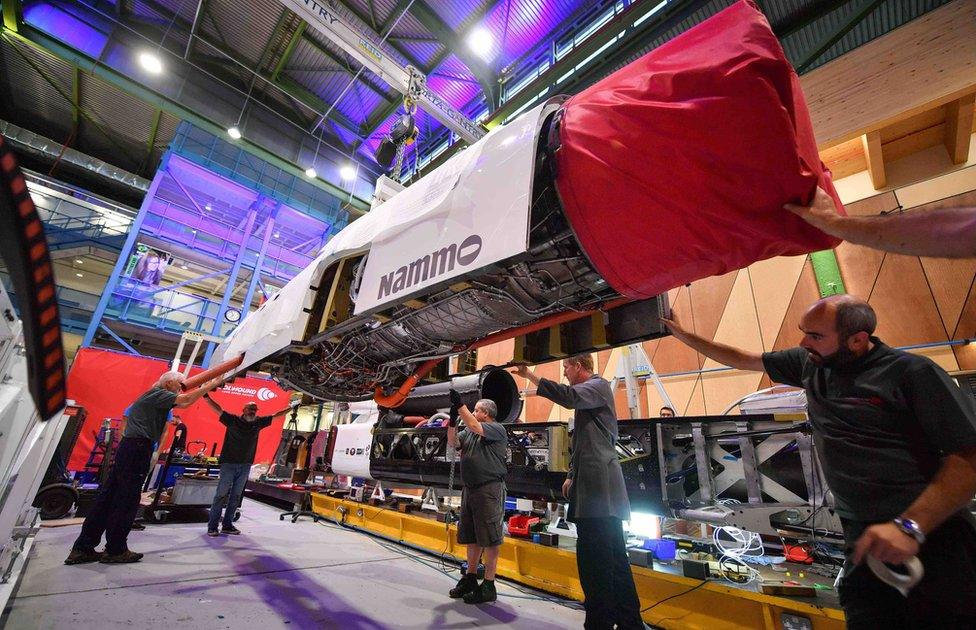
The jet flies in
With the arrival of all the bits of the car, both big and small, the team has raced to fit them all together over the past few weeks.
Each bit then needs testing to make sure it will work when we unpack it 5,500 miles away in South Africa.
This includes the complex jet engine systems, which have to mimic the controls of the Eurofighter-Typhoon to make the jet engine think it's at home.
Our first attempt to simulate a jet engine start was unsuccessful (I would emphasise the word "simulate" - we've got a great relationship with our hosts at Berkeley Green UTC, but if we fired up a jet engine inside the college, the relationship might become a little strained).
Our brilliant systems guru Joe Holdsworth quickly diagnosed that the high-speed digital comms link between the engine and the car had failed to start up correctly.
The solution? The same one you and I would use - switch it off, then switch it back on again!
Last week I watched the wheel hubs being assembled. These are beautiful bits of engineering, containing not just one, or even two, but three separate high-speed wheel bearings on each wheel, giving us a huge amount of redundancy (and hence safety).
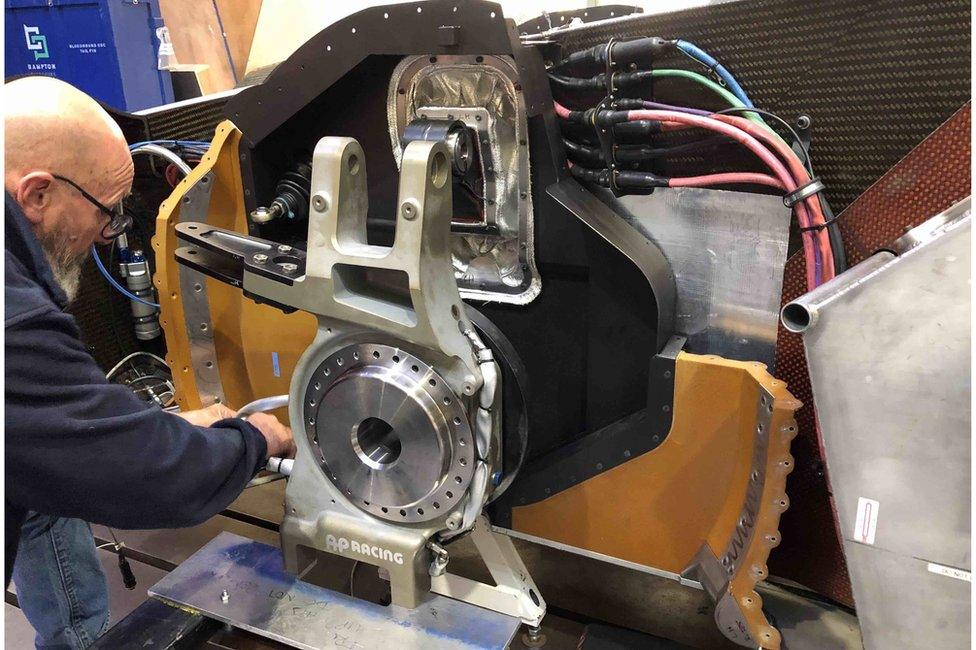
Hubs in place
The wheel hubs are an "interference fit" inside the wheel bearings. In other words, they are so precisely machined that the parts grip each other tight when fitted together.
In turn, this extremely tight fit requires a special assembly method.
Each hub is left in the freezer overnight, which causes it to shrink very slightly. When the hub is brought out of the freezer and dropped into the bearing housing, it slides in snugly. As the hub gradually warms up to room temperature, it expands by a fraction of a millimetre and, because the clearance is so small, it locks in place inside the bearings. Hopefully we won't have to take them out again.
There have also been some interesting discoveries during the car assembly.
One of the less welcome ones was a broken retainer on a pin in the suspension assembly. We believe that this device was originally weakened/damaged by some of the high bump loads we had during our Newquay test session a couple of years ago. A fix is already being put in place to make sure it doesn't happen again.
Bits do break on racing cars and land speed record racing is no different.
Every time we run the car over the next few weeks, there will be a large range of engineering checks to look for exactly this sort of problem.
It will take time, but that's fine by me; it's all part of the process of doing this as safely as possible.
While we've been busy getting the car ready, the Northern Cape government has been doing some terrific work to get the desert fully race ready.
Although the desert clearance was largely completed a couple of years ago, the annual rains have revealed some more bits and pieces of rock that need to be removed.
Allow X content?
This article contains content provided by X. We ask for your permission before anything is loaded, as they may be using cookies and other technologies. You may want to read X’s cookie policy, external and privacy policy, external before accepting. To view this content choose ‘accept and continue’.

In addition, as the desert gradually "rehabilitates" following the surface repairs of the past few years, and with the wear and tear of local traffic, there are some minor ridges and ruts that need to be smoothed out.
Stuart Edmondson, our director of engineering operations, was on the pan a few days ago and sent a short clip of video to show us just what a great job they are doing (thank you, Northern Cape!).
The other exciting image from the pan is Bloodhound's new home-from-home being assembled.
The engineering workshop/hangar is being erected on the eastern side of the pan, roughly opposite the mid-point of the track. It's next to some key facilities, including the joint control room that we will run with the South Africans and (perhaps more importantly) the only toilet facilities for about 20 miles in any direction.
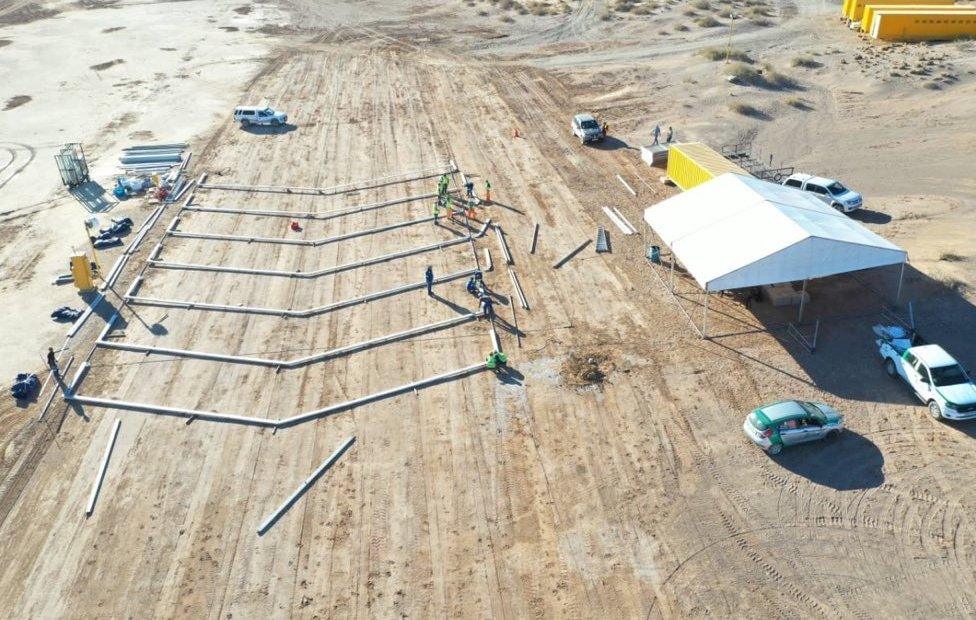
Building the kennel
When we arrive out in South Africa, we'll have to get the car ready to run on the desert. After taking it off its airfreight pallet, the car will need to have the 90kg metal desert wheels fitted, along with the all-important tail fin that will keep it pointy-end forwards.
Once everything has been checked over, we'll be ready to start our high-speed test programme.
Every single run will have a detailed schedule, known as the "run profile", with a target speed and a list of test objectives. We're planning on up to 12 run profiles, with the later runs depending on the results from the first few tests. At the moment, the test programme is looking roughly like this:
Profile 1 - static engine test, followed by a very slow-speed (max 100mph) check of the steering and brakes.
Profile 2 - 200mph, using max dry power on the jet engine, then a coast-down to establish rolling resistance.
Profile 3 - 350mph, using full reheat, with lateral stability tests before and after peak speed, then a coast-down period after engine shutdown to measure rolling resistance without idle thrust from the jet engine.
Profile 4 - 400mph, using full reheat, with stability tests before and after peak speed, followed by the first brake chute test.
Profile 5 - 450mph, full reheat, stability checks, brake chute test.
Profile 6 - 500mph, full reheat, stability checks, double brake chute test.
Profiles 7-12 - these will be defined in detail once we've got the results of the early runs, so we'll all have to wait a bit to find out how much faster we can go!
Don't get too excited, though. For those of you who are already multiplying the number of 7-12 profiles by 50mph jumps, that's not what we're planning. A couple of the remaining profiles will explore the peak speed of Bloodhound, while the rest are scheduled for engineering trials, including airbrake tests at reduced speeds.
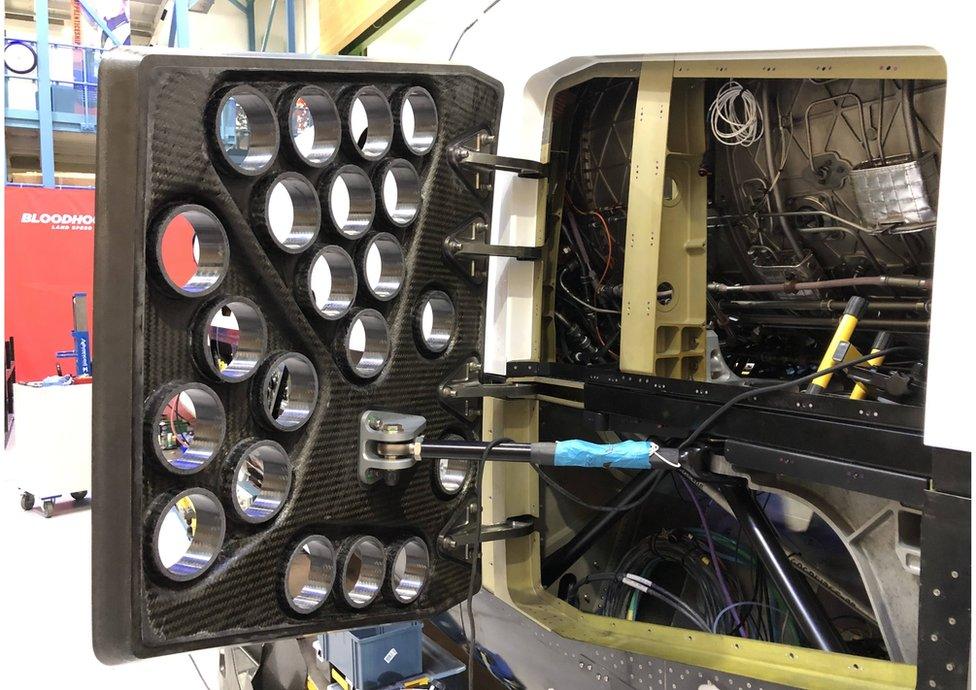
Air brakes to be tested
For me as the driver, there is some good news and some bad news.
The good news is that I don't have to memorise this whole list. Each time we run the car, the team will agree the exact details of the profile(s) the day before we run.
The bad news for me is that I will then have to memorise all the details of the agreed profile(s), so that I can reproduce them exactly when the car is screaming along at several hundred miles an hour. It's all in a day's work.

It'll be a busy office from day one
Each run will have a long list of test objectives. Looking at the "simple" example of profile 1, this is just a slow-speed test of the steering and brakes. To fit all the test points in, I'm planning to break the run up into three phases, possibly more.
My "supersonic office" is going to keep me busy right from day one.
For the first test run, we'll start with phase 1, a static engine test, to check engine start-up procedure, check for leaks and check the onboard systems.
After that, phase 2 will be the first rolling test. A gentle increase in the throttle will determine the power required to move the car away from rest, followed by a check of the steering feel and response with the desert wheels.
I will also need to check that the digital back-up speedo matches the main speedo as we accelerate, and that the cockpit distance counter (used in later runs as one of the cues for chute deployment) is working and can be reset between phases.
At the end of phase 2, I'll gently brake to a stop, monitor the brake pressure required and keep an eye on the brake temperatures to confirm the thermocouples appear to be working.
Phase 3 of the first test run (which we may need to repeat a couple of times) will use gentle acceleration (no reheat) to accelerate to a maximum of 100 mph.
After selecting the jet to idle, I'll gradually increase the brake pressures to find the maximum grip level of the metal wheels on the desert, keeping a careful eye on brake temperatures as well.
There's more to add to that list, but you get the general idea.
One of the key things that we are looking at during high-speed testing this year is the chute deployment sequence.
Bloodhound's chutes are based on the tried-and-tested systems used for both Thrust SSC (the current record holder) and its predecessor, Thrust 2, way back in 1983, external.
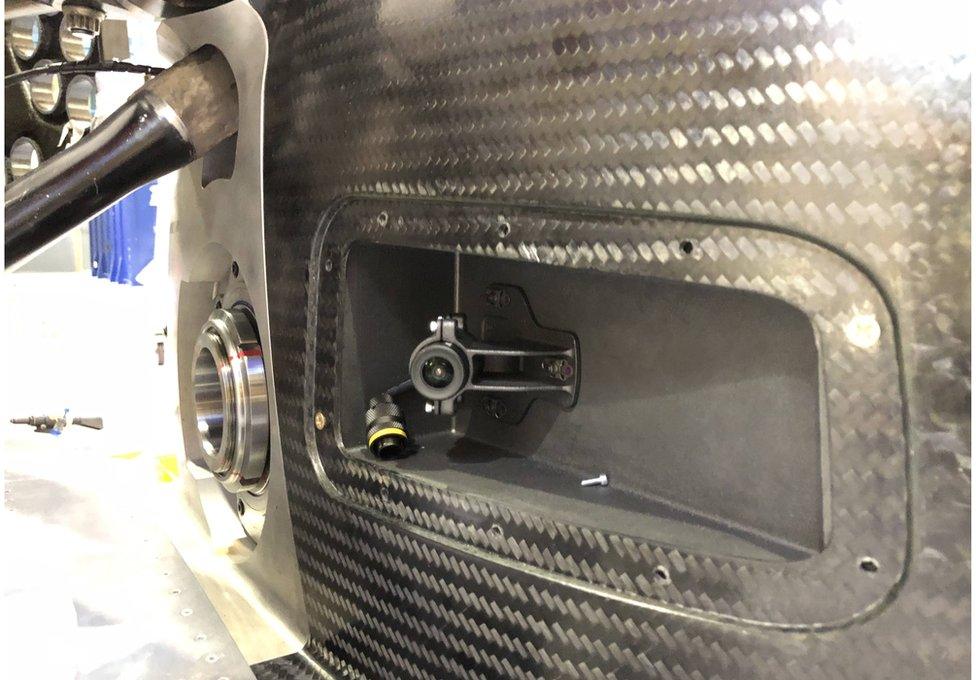
Watching the chutes
As you'd expect, we've made a couple of small changes to try to improve the system, so we need to test these.
The problem with testing brake chutes is that it's almost impossible to measure what is happening during the deployment.
The only way to find out is to video each and every deployment to see what happens (or doesn't happen!).
To watch the chutes, we've built video cameras into the rear wheel fairings on both sides. They'll produce some really exciting shots of jet engine reheat and the desert tearing past at 500+ mph, all of which we will be posting on the Bloodhound website, external over the next few weeks.
Their main job, though, is to capture that fraction of a second at the end of a run when the chute comes out to play, so that we can make sure it's playing nicely.
Finally, when we get to South Africa, I'll get to wear the new "Bloodhound LSR" race helmet for the first time.
The colour scheme is based on two winning entries for our helmet design competition, run all the way back in 2013.
My personal thanks to Sam James (11 years old at the time) and Cerys Rogers (then 14) for their cracking designs (and to "Ringo" for the superb artwork of course) - sorry it took so long, guys. I hope you both like the finished article.

- Published31 July 2019
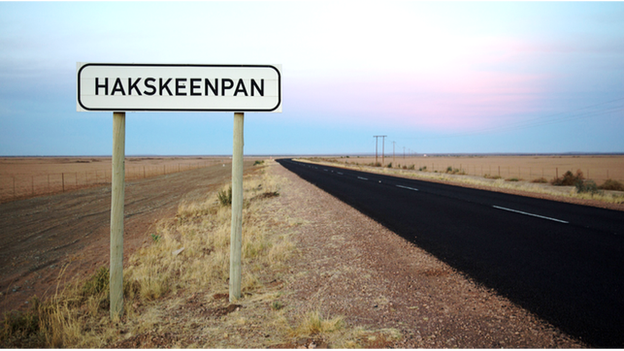
- Published10 July 2019
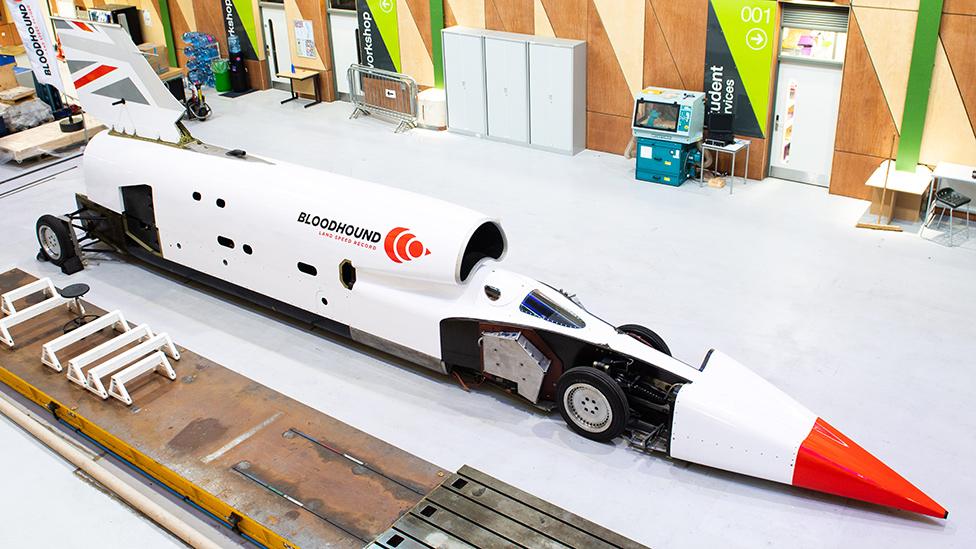
- Published11 June 2019

- Published28 March 2019
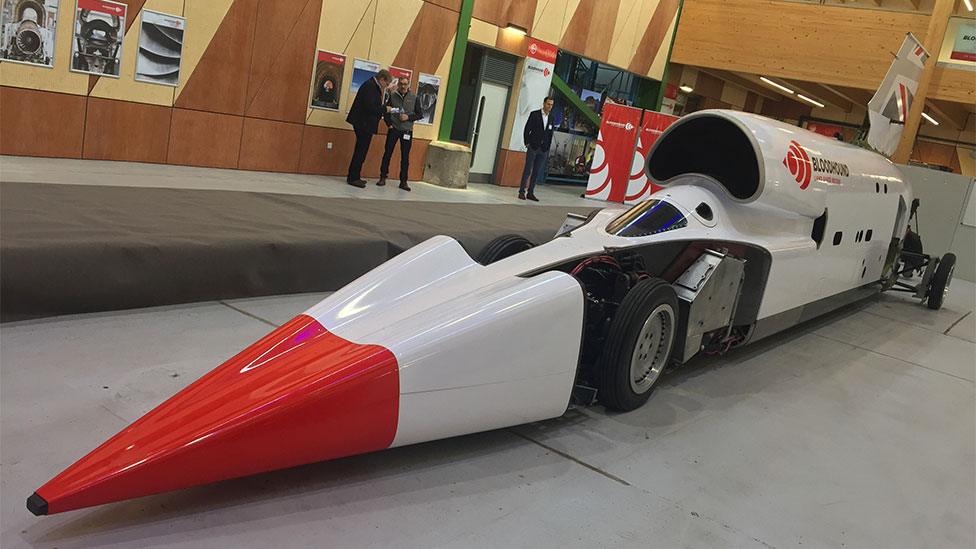
- Published21 March 2019
